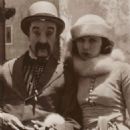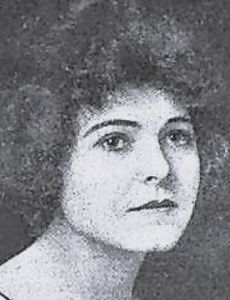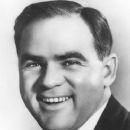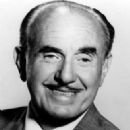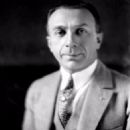Hal Roach
Active - 1915 - 1984 | Born - Jan 14, 1892 in Elmira, NY | Died - Nov 2, 1992 in Los Angeles, CA | Genres - Comedy
Biography by Hal Erickson
American producer/director Hal Roach was overtaken by wanderlust early in life. Leaving his upstate New York home in his teens, Roach was an Alaskan gold prospector and mule skinner before he reached the age of twenty. In 1912, he spotted an ad placed by Hollywood's Universal Pictures offering a dollar a day for genuine cowboys to act as western technical advisers. Roach spent the next year making the rounds as an extra, in the company of his new friend Harold Lloyd. As the result of a small inheritance, Roach bought an office in Los Angeles' Bradbury Mansion in 1914, set up a small film production unit, and hired Lloyd as his star comedian. Roach's initial "Willie Work" one-reelers found no buyers, and, when the funds ran out, Lloyd left briefly for Keystone while Roach signed on as a director with the Chaplin unit at Essanay. Teaming with Dan Lintchicum, Roach re-entered the production end with his new Rolin Phunphilm Company; Lloyd returned to the fold, this time as a Chaplin rip-off character named Lonesome Luke. Throughout 1916 and 1917, Roach released his "Luke" comedies through Pathe; the films were popular not only because of the seemingly bottomless reserve of sight gags, but also because Roach insisted upon emphasizing strong story values as well as slapstick. In 1917, Lloyd dropped his "Luke" makeup in favor of his now-famous "glasses" character. While both Lloyd and Roach would later take credit for hitting upon the innovation of allowing a comedian to play "himself" rather than a heavily made-up buffoon, the important end result was that Lloyd became the most popular comic working in films. To ensure a consistency of product, Roach set up a preview system for the Lloyd comedies, screening them before test audiences and re-editing them for full comic impact before their general release. Roach began adding to his comic roster in 1919, building comedies around such stars as Snub Pollard, Stan Laurel, and black youngster "Sunshine" Sammy Morrison. He also gave a free creative hand to such writers and directors as Charley Chase, Alf Goulding, and Fred Newmeyer, who controlled the output while Roach concentrated on administrative duties. Chancing to see a couple of kids arguing over a block of wood in 1922, Roach decided that a series of comedies built around the joys and problems of real-life children would clean up at the box office. The result was "Our Gang", one of the longest-lasting short subjects series of all time (1922-44). Writer/director Charley Chase became Roach's top comedian after Lloyd left in 1924, turning out a successful yearly manifest of sophisticated domestic comedies; many of these were directed by Leo McCarey, who became Roach's supervising director. According to many contemporaries, it was McCarey and not Roach who first fully realized the potential of teaming comedian/gagman/director Stan Laurel with supporting actor Oliver Hardy in late 1926 -- culminating in the most successful series of two-reelers ever made at the Roach Studio. Unlike other independents, Roach was not intimidated in the least by the coming of sound in 1929. A sweetheart deal with RCA Victor and Western Electric enabled Roach to turn out the most technically proficient talkie shorts on the market, enhanced by the lilting background music scores (another innovation) written by LeRoy Shield and Marvin Hatley. With Stan Laurel and Oliver Hardy, Our Gang, and Charley Chase going full blast in the early 1930s, Roach developed several new series: The Boy Friends, The Taxi Boys, Thelma Todd/ZaSu Pitts and Thelma Todd/Patsy Kelly. Committed to the short subject form, Roach declared that he wanted to make 20-minute films with the production gloss usually associated with feature films. But the diminishing shorts market in the mid 1930s forced Roach to rethink his policy and concentrate on feature films. He'd been making features sporadically since the Harold Lloyd days in 1922. His two most successful productions, Lloyd's Grandma's Boy (1922) and Laurel and Hardy's The Devil's Brother (1933), were both feature-length, and there was also a brief series of silent multi-reelers starring Rex the Wonder Horse. In 1935, Roach began curtailing his two-reel activity by phasing out the Laurel and Hardy shorts. A year later, Charley Chase was let go, and, in 1938, the last-ever Roach short subject, Our Gang's Hide and Shriek, was issued through MGM. Roach's subsequent feature output included his always popularLaurel and Hardy and the three Topper films. In 1938, Roach switched distribution from MGM to United Artists, turning out such feature successes as There Goes My Heart (1938), Captain Fury (1939), and the pioneering special-effects extravaganza One Million BC (1940). As a result of a lawsuit with director Lewis Milestone, Roach agreed to produce Milestone's Of Mice and Men (1939), perhaps the studio's best non-comic effort. In 1941, Roach came up with the concept of "Streamliners" -- 45-minute films especially designed for double bills. While some of these were successful (notably a series of service comedies starring Joe Sawyer and William Tracy), many were on a par with the notorious The Devil With Hitler (1943). In the last two years of World War II, Hal Roach received a Colonel's commission and turned his studio over to the government for the purpose of making training films -- Ronald Reagan spent most of his military service as an actor at "Fort Roach." In the late 1940s, Roach found it difficult to regain his footing in theatrical films. Undaunted, he switched to turning out TV films; he was the first major Hollywood producer to do so. Among the 1950s series filmed at the Roach lot were My Little Margie, Amos 'n' Andy, Topper, Racket Squad, and The Abbott and Costello Show. Though seldom making a false career move, Roach was nearly scuttled by an ill-advised association with Benito Mussolini in the 1930s. Two decades later, he made his most injurious error by turning his operation over to Hal Roach Jr., who entered into a partnership with a "businessman" of dubious character -- a move which bankrupted the studio. Though his sound stages were demolished in 1963, Hal Roach remained active into the 1980s, overseeing theatrical, TV, and home-movie distribution of his films and participating in the formative years of cable television and computer colorization. Roach received an honorary Oscar at the age of 92; he lived long enough to be honored again at the Academy Awards telecast of 1992 -- looking at least thirty years younger than his actual age of 100.
http://www.allmovie.com/artist/hal-roach-p108408
You can find people similar to Hal Roach by visiting our lists Male actors of Irish descent and Producers of Live Action Short Film Academy Award winners.
| Full name at birth | Harry Eugene Roach
|
||
| Claim to fame | The Our Gang and Laurel and Hardy series
|
||
| Date of birth | 14 January 1892
|
||
| Place of birth | Elmira, New York
|
||
| Date of death | 2 November 1992
|
||
| Age | 100 (age at death)
|
||
| Place of death | Los Angeles, California
|
||
| Cause of death | Pneumonia
|
||
| Resting place | Woodlawn Cemetery
|
||
| Occupation | Director/Producer
|
||
| Occupation category | |||
| Nationality |
PERSONAL DETAILS
| Height |
|
||
| Build |
|
||
| Hair color |
|
||
| Eye color |
|
||
| Gender | |||
| Ethnicity |
|
||
| Religion |
|
||
| Zodiac sign | |||
| Distinctive feature |
|
||
| Pets |
|
ADDITIONAL DETAILS
| High school |
|
||
| University |
|
||
| Talent agency |
|
||
| Political affiliation |
|
||
| Political party |
|
- Grandfather of Addison Randall
- Father of Margaret Roach
- His product was initially distributed by U.S. branch of Pathe. Ironically, this was the same distributor his arch-rival Mack Sennett. Once the French firm imploded in the mid-1920's, Sennett's fate was sealed while Hal Roach's boutique studio retained enough clout through the "Our Gang" franchise (amongst others) to secure a lucrative deal with MGM, despite his break with Harold Lloyd.
- Developed appendicitis during the filming of Babes in Toyland (1934).
- He had frequently told the story of sitting in his office in 1921 and watching some kids playing in a nearby lot. The kids were playfully arguing over a stick as if were the most important thing in the world. He realized that he had been fascinated over their antics and was amazed to realize he'd failed how much time had passed watching these kids at play. The led to the idea for the "Our Gang" comedies, which became--- after Harold Lloyd (who'd soon leave for independent production), Roach's most profitable property and, with innumerable cast changes, the longest running short series in Hollywood history (sold to MGM in 1937 and continuing through 1944).
Hal Roach is known for his role in the film The Florida Project (2017) as a special thanks from the director / special thanks: from the director for continuing inspiration.
More...
- Albums (5) keyboard_arrow_right
- Songs (9) keyboard_arrow_right
- Quotes (3) keyboard_arrow_right
- Trivia (7) keyboard_arrow_right
- Pictorials (1) keyboard_arrow_right
- Magazines (1) keyboard_arrow_right
- Photos (30) keyboard_arrow_right
- Lists (13) keyboard_arrow_right
- Filmography (1,877) keyboard_arrow_right
- Awards (6) keyboard_arrow_right
- Fans (5) keyboard_arrow_right
This page is the FamousFix profile for Hal Roach. Content on this page is contributed by editors who belong to our editorial community. We welcome your contributions... so please create an account if you would like to collaborate with other editor's in helping to shape this website.
On the Hal Roach page you will be able to add and update factual information, post media and connect this topic to other topics on the website. This website does skew towards famous actors, musicians, models and sports stars, however we would like to expand that to include many other interesting topics.




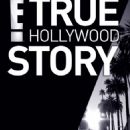


![Hal Roach - Yours Retro Magazine Pictorial [United Kingdom] (March 2024)](http://img3.bdbphotos.com/images/130x130/m/6/m6lpqvs9r6dg6msp.jpg?skj2io4l)
